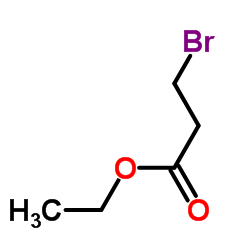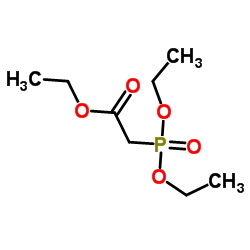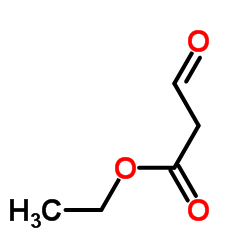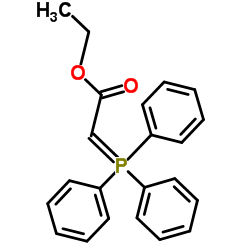trans-2-butene-1,4-dicarboxylic acid diethyl ester

trans-2-butene-1,4-dicarboxylic acid diethyl ester structure
|
Common Name | trans-2-butene-1,4-dicarboxylic acid diethyl ester | ||
|---|---|---|---|---|
| CAS Number | 77116-74-6 | Molecular Weight | 200.23200 | |
| Density | 1.04 | Boiling Point | 259.4ºC at 760 mmHg | |
| Molecular Formula | C10H16O4 | Melting Point | 195-196ºC | |
| MSDS | N/A | Flash Point | 120.2ºC | |
| Name | trans-2-butene-1,4-dicarboxylic acid diethyl ester |
|---|---|
| Synonym | More Synonyms |
| Density | 1.04 |
|---|---|
| Boiling Point | 259.4ºC at 760 mmHg |
| Melting Point | 195-196ºC |
| Molecular Formula | C10H16O4 |
| Molecular Weight | 200.23200 |
| Flash Point | 120.2ºC |
| Exact Mass | 200.10500 |
| PSA | 52.60000 |
| LogP | 1.44900 |
| Index of Refraction | 1.448 |
|
Section I.Chemical Product and Company Identification Chemical Name trans-2-Butene-1,4-dicarboxylic Acid Diethyl Ester Portland OR SynonymDiethyl trans-2-Butene-1,4-Dicarboxylate Chemical FormulaC2H5O2CH2CHC:CHCH2CO2C2H5 CAS Number77116-74-6 Section II.Composition and Information on Ingredients Chemical NameCAS Number Percent (%)TLV/PELToxicology Data trans-2-Butene-1,4-dicarboxylic Acid Diethyl Ester77116-74-6Min. 98.0 Not available.Not available. (GC) Section III. Hazards Identification Acute Health EffectsNo specific information is available in our data base regarding the toxic effects of this material for humans. However, exposure to any chemical should be kept to a minimum. Skin and eye contact may result in irritation. May be harmful if inhaled or ingested. Always follow safe industrial hygiene practices and wear proper protective equipment when handling this compound. CARCINOGENIC EFFECTS : Not available. Chronic Health Effects MUTAGENIC EFFECTS : Not available. TERATOGENIC EFFECTS : Not available. Toxicity to the reproductive system: Not available. There is no known effect from chronic exposure to this product. Repeated or prolonged exposure to this compound is not known to aggravate existing medical conditions. Section IV.First Aid Measures Eye ContactCheck for and remove any contact lenses. DO NOT use an eye ointment. Flush eyes with running water for a minimum of 15 minutes, occasionally lifting the upper and lower eyelids. Seek medical attention. Treat symptomatically and supportively. Skin ContactIf the chemical gets spilled on a clothed portion of the body, remove the contaminated clothes as quickly as possible, protecting your own hands and body. Place the victim under a deluge shower. If the chemical touches the victim's exposed skin, such as the hands: Gently and thoroughly wash the contaminated skin with running water and non-abrasive soap. Be particularly careful to clean folds, crevices, creases and groin. Cover the irritated skin with an emollient. Seek medical attention. Treat symptomatically and supportively. Wash any contaminated clothing before reusing. InhalationIf the victim is not breathing, perform artificial respiration. Loosen tight clothing such as a collar, tie, belt or waistband. If breathing is difficult, oxygen can be administered. Seek medical attention. Treat symptomatically and supportively. Remove dentures if any. Have conscious person drink several glasses of water or milk. INDUCE VOMITING by sticking Ingestion finger in throat. Lower the head so that the vomit will not reenter the mouth and throat. NEVER give an unconscious person anything to ingest. Seek medical attention. Treat symptomatically and supportively. Section V. Fire and Explosion Data Not available. FlammabilityCombustible.Auto-Ignition Flammable Limits Flash PointsNot available. Not available. Combustion ProductsThese products are toxic carbon oxides (CO, CO 2). Fire Hazards No specific information is available regarding the flammability of this compound in the presence of various materials. Explosion HazardsRisks of explosion of the product in presence of mechanical impact: Not available. Risks of explosion of the product in presence of static discharge: Not available. No additional information is available regarding the risks of explosion. Fire Fighting Media SMALL FIRE: Use DRY chemicals, CO 2, water spray or foam. LARGE FIRE: Use water spray, fog or foam. DO NOT use water jet. and Instructions Continued on Next Page trans-2-Butene-1,4-dicarboxylic Acid Diethyl Ester Section VI.Accidental Release Measures Spill CleanupCombustible material. InstructionsKeep away from heat and sources of ignition. Mechanical exhaust required. Stop leak if without risk. Finish cleaning the spill by rinsing any contaminated surfaces with copious amounts of water. Consult federal, state, and/or local authorities for assistance on disposal. Section VII. Handling and Storage Handling and StorageKeep away from heat and sources of ignition. Mechanical exhaust required. When not in use, tightly seal the container and store in a dry, cool place. Avoid excessive heat and light. Do not breathe gas, fumes, vapor or spray. In case of Information insufficient ventilation, wear suitable respiratory equipment. If you feel unwell, seek medical attention and show the label when possible. Treat symptomatically and supportively. Avoid contact with skin and eyes. Always store away from incompatible compounds such as oxidizing agents. Section VIII. Exposure Controls/Personal Protection Engineering ControlsProvide exhaust ventilation or other engineering controls to keep the airborne concentrations of vapors below their respective threshold limit value. Ensure that eyewash station and safety shower is proximal to the work-station location. Personal ProtectionSplash goggles. Lab coat. Vapor respirator. Boots. Gloves. A MSHA/NIOSH approved respirator must be used to avoid inhalation of the product. Suggested protective clothing might not be sufficient; consult a specialist BEFORE handling this product. Exposure LimitsNot available. Section IX. Physical and Chemical Properties Solubility Physical state @ 20°CLiquid.Not available. 1.04 Specific Gravity Molecular Weight200.23Partition CoefficientNot available. Boiling Point115 to 118°C @ 2mmHgVapor PressureNot available. Melting PointNot available.Vapor DensityNot available. Not available.VolatilityNot available. Refractive Index Critical TemperatureNot available.OdorNot available. ViscosityNot available.TasteNot available. Section X.Stability and Reactivity Data Stability This material is stable if stored under proper conditions. (See Section VII for instructions) Conditions of InstabilityAvoid excessive heat and light. Incompatibilities Reactive with strong oxidizing agents. Section XI. Toxicological Information RTECS NumberNot available. Eye contact. Ingestion. Inhalation. Routes of Exposure Toxicity DataNot available. Chronic Toxic EffectsCARCINOGENIC EFFECTS : Not available. MUTAGENIC EFFECTS : Not available. TERATOGENIC EFFECTS : Not available. Toxicity to the reproductive system: Not available. There is no known effect from chronic exposure to this product. Repeated or prolonged exposure to this compound is not known to aggravate existing medical conditions. No specific information is available in our data base regarding the toxic effects of this material for humans. However, Acute Toxic Effects exposure to any chemical should be kept to a minimum. Skin and eye contact may result in irritation. May be harmful if inhaled or ingested. Always follow safe industrial hygiene practices and wear proper protective equipment when handling this compound. Continued on Next Page trans-2-Butene-1,4-dicarboxylic Acid Diethyl Ester Section XII.Ecological Information EcotoxicityNot available. Not available. Environmental Fate Section XIII. Disposal Considerations Recycle to process, if possible. Consult your local or regional authorities. You may be able to dissolve or mix material with Waste Disposal a combustible solvent and burn in a chemical incinerator equipped with an afterburner and scrubber system. Observe all federal, state, and local regulations when disposing of this substance. Section XIV. Transport Information DOT ClassificationNot a DOT controlled material (United States). Not available. PIN Number Proper Shipping Name Not available. Packing Group (PG)Not available. DOT Pictograms Section XV. Other Regulatory Information and Pictograms TSCA Chemical InventoryThis product is NOT on the EPA Toxic Substances Control Act (TSCA) inventory. The following notices are required by 40 CFR 720.36 (C) for those products not on the inventory list: (EPA) (i) These products are supplied solely for use in research and development by or under the supervision of a technically qualified individual as defined in 40 CFR 720.0 et sec. (ii) The health risks of these products have not been fully determined. Any information that is or becomes available will be supplied on an MSDS sheet. WHMIS ClassificationNot controlled under WHMIS (Canada). (Canada) EINECS Number (EEC) Not available. EEC Risk StatementsNot available. SECTION 16 - ADDITIONAL INFORMATION N/A |
| Risk Phrases | 36/37/38 |
|---|---|
| Safety Phrases | 26-36/37/39 |
| HS Code | 2917190090 |
|
~62% 
trans-2-butene-... CAS#:77116-74-6 |
| Literature: Baldwin, Jack E.; Kelly, David R. Journal of the Chemical Society, Chemical Communications, 1985 , # 11 p. 682 - 684 |
|
~95% 
trans-2-butene-... CAS#:77116-74-6 |
| Literature: Verma, Rekha; Ghosh, Sunil K. Journal of the Chemical Society - Perkin Transactions 1, 1998 , # 15 p. 2377 - 2381 |
|
~% 
trans-2-butene-... CAS#:77116-74-6 |
| Literature: Yamaguchi, Masahiko; Hasebe, Koichi; Tanaka, Shinya; Minami, Toru Tetrahedron Letters, 1986 , vol. 27, # 8 p. 959 - 962 |
|
~% 
trans-2-butene-... CAS#:77116-74-6 |
| Literature: Pirillo; Leggeri; Traverso Farmaco, Edizione Scientifica, 1984 , vol. 39, # 11 p. 963 - 967 |
|
~% 
trans-2-butene-... CAS#:77116-74-6 |
| Literature: Pino Atti della Accademia Nazionale dei Lincei, Classe di Scienze Fisiche, Matematiche e Naturali, Rendiconti, 1954 , vol. <8> 16, p. 640,643 |
|
~% 
trans-2-butene-... CAS#:77116-74-6 |
| Literature: Oehme, G.; Pracejus, H. Journal fuer Praktische Chemie (Leipzig), 1980 , vol. 322, # 5 p. 798 - 808 |
| Precursor 10 | |
|---|---|
| DownStream 0 | |
| HS Code | 2917190090 |
|---|---|
| Summary | 2917190090 acyclic polycarboxylic acids, their anhydrides, halides, peroxides, peroxyacids and their derivatives VAT:17.0% Tax rebate rate:9.0% Supervision conditions:none MFN tariff:6.5% General tariff:30.0% |
| hex-2t-enedioic acid diethyl ester |
| Diethyl trans-3-Hexenedioate |
| trans-2-Butene-1,4-dicarboxylic Acid Diethyl Ester trans-3-Hexenedioic Acid Diethyl Ester Diethyl trans-2-Butene-1,4-dicarboxylate |
| TRANS-3-HEXENEDIOIC ACID DIETHYL ESTER |
| Hex-2t-endisaeure-diaethylester |
| DIETHYL TRANS-2-BUTENE-1,4-DICARBOXYLATE |









